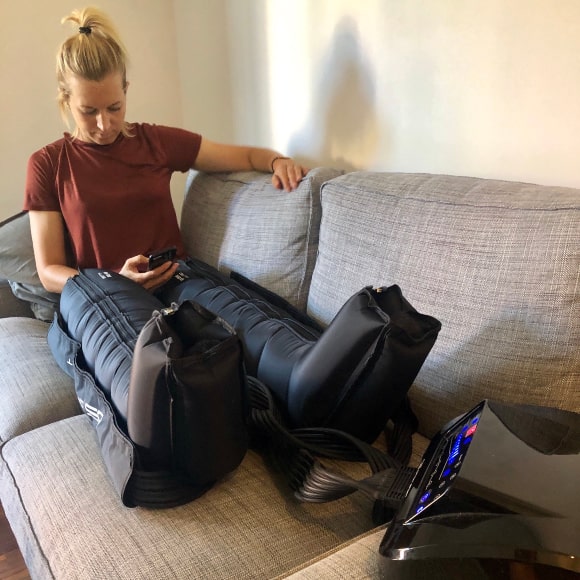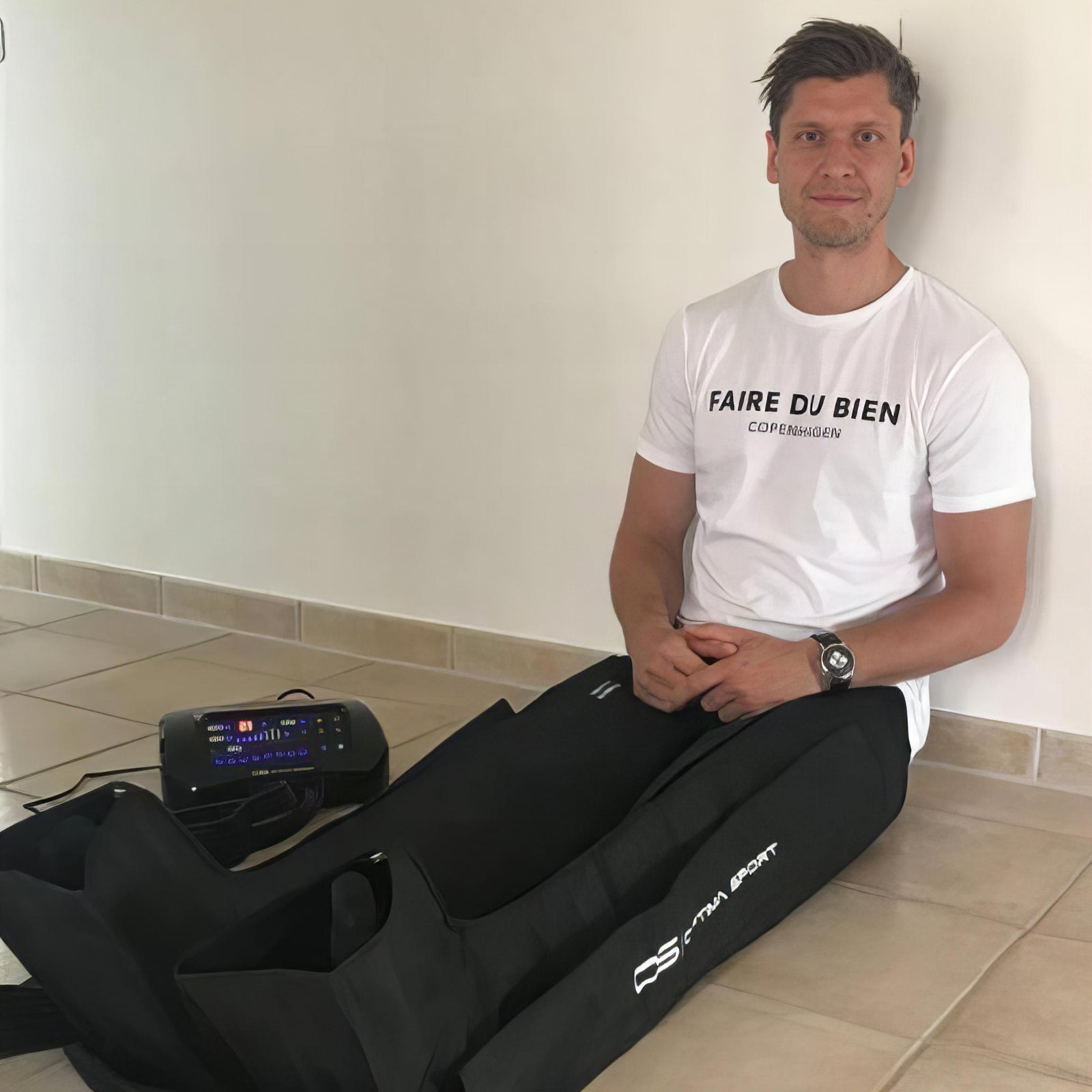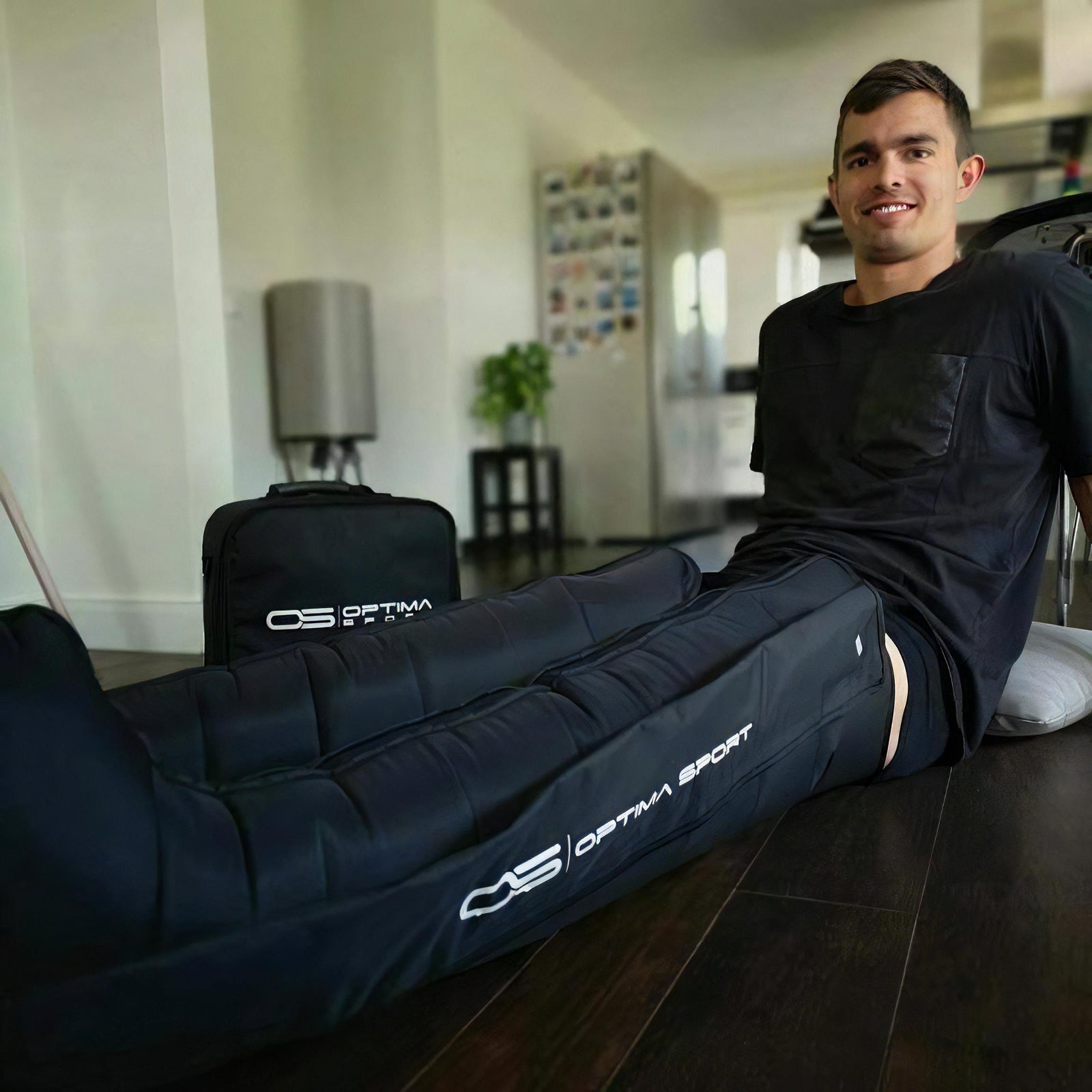Really good product, and easy to use. Works perfectly and is fantastic after a long day of work or a run ☺️
Hip and Glutes Injuries in Sports: A Comprehensive Guide
Whether you're an elite athlete or an avid exerciser, there's a good chance you've experienced some discomfort in your hips or glutes. Understanding these injuries and how to manage them can make all the difference in your athletic career or fitness journey. This comprehensive guide will provide valuable insights into common hip and glutes injuries, their causes, symptoms, and effective treatments, along with tips for prevention.

Advanced Recovery Gear for Hip and Gluteal Health
Treating hip and gluteal injuries is crucial for athletes and avid exercisers. Incorporating electrical tools into your recovery routine can significantly enhance healing and performance.
Devices like recovery boots, PowerDots, and massage guns provide targeted relief through advanced technology. Recovery boots use compression therapy to improve blood flow and reduce swelling, accelerating the healing process. PowerDots deliver electrical muscle stimulation, promoting muscle recovery, reducing pain, and preventing muscle atrophy. Massage guns offer deep tissue massage, effectively releasing muscle tension, reducing soreness, and enhancing flexibility.
These tools not only alleviate current discomfort but also help prevent future injuries, ensuring you stay at your peak performance level. Recovery boots can be used post-exercise to flush out metabolic waste and bring fresh oxygenated blood to the muscles. PowerDots are portable and can be used anytime to keep your muscles activated and ready for action. Massage guns are perfect for targeting specific muscle groups, offering quick relief and aiding in faster recovery.
Integrating these innovative devices into your daily regimen can make a substantial difference in your recovery process, allowing you to train harder and recover smarter. Equip your recovery toolkit with these advanced tools to ensure effective and efficient recovery from hip and gluteal injuries, keeping you on track with your fitness goals.
Hip and Glute Injuries: Finding Relief with Electrical Massage Tools
Optima-Go Mini-Massagepistole
Hip and gluteal injuries can significantly impact your athletic performance and daily activities. The Mini Massage Gun offers a practical solution for targeted pain relief and faster recovery.
This compact device delivers powerful, deep-tissue massage to alleviate muscle tension and promote healing in the hip and gluteal areas. To use, turn on the massage gun, select your desired intensity, and gently apply it to the affected area. Move the device slowly over the muscles in your hips and glutes, allowing the vibrations to penetrate deeply and relieve discomfort.
The Mini Massage Gun’s lightweight design and portability make it perfect for on-the-go use, ensuring you have relief whenever and wherever you need it. With its ergonomic handle and multiple intensity settings, this tool is easy to use and highly effective in managing hip and gluteal injuries.
PowerDot 2.0 Duo
Combat hip and gluteal injuries that hinder your performance with the PowerDot 2.0 Duo, an effective solution for pain relief and muscle recovery.
This innovative device uses electrical muscle stimulation (EMS) to target deep muscle tissues, enhancing recovery and reducing pain.
To use, simply attach the electrodes to the affected areas of your hips and glutes, select a program via the app, and let the PowerDot work its magic. This video show how to use PowerDots on your glutes.
The app guides you through the process, making it user-friendly and efficient.
The PowerDot 2.0 Duo’s portable design and customizable programs make it ideal for athletes and avid exercisers seeking quick and effective recovery. With its ability to relieve pain, enhance muscle recovery, and prevent future injuries, this device is a must-have for your recovery toolkit.
Recovery Pants 8 Kammern Akku Gen2
The Recovery Pants K8 Battery Gen2 offers an effective solution for pain relief and muscle recovery, helping you overcome hip and gluteal injuries that greatly affect your performance and daily life.
These advanced recovery pants use dynamic compression technology to enhance blood flow, reduce swelling, and accelerate muscle recovery.
To use, simply wear the pants, connect the machine, and select your preferred recovery program. The pants will deliver targeted compression to your hips and glutes, helping alleviate discomfort and promote healing.
The Recovery Pants K8 Battery Gen2’s portable design and customizable settings make it ideal for athletes and avid exercisers seeking efficient recovery. With the ability to relieve pain, reduce muscle stiffness, and prevent future injuries, these pants are an essential addition to your recovery toolkit.
Hüftshorts inklusive Schläuche - 8 Luftkammern
If hip and gluteal injuries are affecting your performance and daily life, the Recovery Hipsters 8 Chambers provide a practical solution for effective pain relief and muscle recovery.
These hipsters are an add-on to our recovery boots and pants and require a recovery machine to function. Using dynamic compression technology, they enhance blood flow, reduce swelling, and speed up muscle recovery in the hip and gluteal areas.
Simply connect them to your existing recovery system, select the desired program, and let the hipsters work their magic.
With the Recovery Hipsters 8 Chambers, you get targeted compression therapy designed specifically to address hip and gluteal pain. Their ergonomic design and customizable settings ensure a comfortable and effective recovery experience, helping you get back to peak performance faster.
Performance
The athletes who use Optima Sport
Many athletes use Optima Sport's products to achieve faster recovery and to recover quickly from injuries.

Effective Tools for Hip and Glute Pain Relief
Managing hip and gluteal injuries is crucial for athletes and avid exercisers. Using trigger point tools like foam rollers and elastic bands can significantly aid your recovery process.
Foam rollers are excellent for massaging tight muscles, breaking up scar tissue, and releasing muscle tension. Advanced models with electric vibration combine pressure and pulsation for deeper muscle relaxation and pain relief.
Elastic bands are versatile, helping to improve flexibility, strength, and stability in the hip and glute areas.
By incorporating these tools into your routine, you can alleviate current discomfort and prevent future injuries. For useful exercises, you can visit this page.
These tools enhance blood flow, reduce muscle stiffness, and promote faster recovery, keeping you on track with your fitness goals.
Regular use not only helps manage pain but also improves overall muscle performance and resilience. Equip your recovery arsenal with these innovative tools to ensure that hip and glute injuries don’t derail your athletic pursuits.
Essential Recovery Tools for Hip and Gluteal Relief
The Blackroll Loop Band offers a practical solution for muscle recovery and strength building, helping you overcome hip and gluteal injuries that can hinder your performance and daily activities.
This versatile loop band is designed to target the hip and gluteal muscles, improving strength and flexibility. To use, incorporate the band into your exercises, such as squats, lunges, and hip bridges, to add resistance and enhance muscle engagement. The loop band helps alleviate pain and promotes faster recovery.
The Blackroll Loop Band’s varied resistance levels make it ideal for athletes and avid exercisers seeking effective recovery. Its ability to enhance muscle strength, flexibility, and prevent future injuries makes it an essential tool in your fitness regimen.
The Blackroll Standard foam roller offers an effective solution for pain relief and muscle recovery, helping you overcome hip and gluteal injuries.
With this foam roller, you can target deep muscle tissues in the hip and gluteal areas, improving blood flow and reducing tension.
To use the foam roller, simply place it on the ground and gently roll over the affected areas. Apply light pressure to release muscle knots and improve flexibility. See this page for more exercises you can make with your foam roller.
The Blackroll Standard is ideal for athletes seeking effective recovery. With this foam roller, you can relieve pain, promote muscle recovery, and prevent future injuries.
Hip and gluteal injuries can severely impact your athletic performance, but the Theragun Wave Solo offers an effective solution for targeted pain relief and muscle recovery.
This compact, smart massage ball uses powerful vibrations to alleviate muscle tension and promote healing in the hip and gluteal areas.
To use, turn on the Wave Solo, select your desired vibration intensity, and gently roll it over the affected areas. Allow the device to penetrate deeply into the muscle tissue, relieving discomfort and enhancing recovery.
The Theragun Wave Solo’s portable design and customizable vibration settings make it ideal for athletes and avid exercisers. With its ability to provide targeted relief and accelerate muscle recovery, this device is a must-have for your recovery toolkit.
If hip and gluteal injuries are affecting your performance, the Theragun 12” Wave Roller provides an effective solution for pain relief and muscle recovery.
This compact and smart massage ball uses powerful vibrations to relieve muscle tension and promote healing in the hip and gluteal areas.
To use the Wave Solo, simply turn it on, select your desired vibration intensity, and gently roll it over the sore areas. Allow the massage ball to penetrate deeply into the muscle tissue to alleviate discomfort and enhance recovery.
By choosing a massage ball over a foam roller, you can better target specific areas with muscle knots. This makes the Wave Solo an ideal tool for targeted pain relief and accelerating muscle recovery.
Excellent guidance over the phone, where I got answers to the questions I had. Afterwards, I received my new Recovery Boots K8 Gen2, which I have already become very fond of - a definite recommendation from here!
Fast and accurate delivery, the follow-up is really good style. My son struggles with heavy legs, and they have really helped here. I myself use them after cycling for recovery and sore muscles. World-class.

Anatomy of the Hip and Glutes
The hip and gluteal regions are composed of a complex structure of bones, muscles, and ligaments. The hip joint is a ball-and-socket joint formed by the femur’s head fitting into the acetabulum of the pelvis, allowing a wide range of motion. Surrounding the joint are powerful muscles, including the gluteus maximus, medius, and minimus, which are responsible for movement and stability. These muscles, along with supporting ligaments and tendons, play a crucial role in various athletic activities, providing strength, balance, and flexibility.
Common Hip and Glutes Injuries
In the realm of sports, some of the most well-known injuries in the hip and gluteal region include hip strains, labral tears, and piriformis syndrome. Hip strains typically occur due to sudden movements or overuse, leading to the tearing of muscle fibers. Athletes often experience this during activities that require quick directional changes or explosive power. Labral tears involve damage to the cartilage ring (labrum) surrounding the hip joint, which can cause significant pain and restricted mobility. This injury is common in sports that require extensive hip rotation, such as soccer, hockey, and dance.
Piriformis syndrome arises when the piriformis muscle, located deep in the buttock, irritates the sciatic nerve. This condition results in pain, tingling, and numbness that can extend down the leg. It’s often seen in runners and athletes who engage in prolonged sitting or repetitive lower body movements. Managing these injuries usually involves a combination of rest, physical therapy, and in some cases, surgical intervention to restore full function. Preventative measures, such as proper warm-up routines, regular stretching, and targeted strength training, are essential to minimize the risk of these common sports-related injuries.
Great product
After just one week with my Recovery Boots from Optima Sport, they already have a noticeable effect. I've been using them daily, especially after runs, and my legs feel significantly less restless after running. I had good communication with Optima Sport before purchasing. Only recommendations from me :-)
Diagnosis of Hip and Glutes Injuries
Clinical Examination
A clinical examination involves a thorough physical assessment to identify symptoms and potential causes.
Physical Assessment Techniques
Techniques include palpation, where the doctor feels the body to detect any abnormalities, as well as range of motion tests and strength assessments.
Common Diagnostic Tests
Common tests include the Thomas Test, which is used to assess the flexibility of the hip flexors, the Ober’s Test, which evaluates the tightness of the iliotibial band (IT band), and the Trendelenburg Test, which helps identify weaknesses in the hip abductors, particularly the muscles around the hip and glutes.
Imaging Techniques
X-rays
X-rays help identify bone abnormalities and fractures.
MRI and CT Scans
MRI and CT scans provide detailed images of soft tissues, helping diagnose ligament and muscle injuries.
Ultrasound
Ultrasound is useful for diagnosing soft tissue injuries and guiding injections.
Treatment and Management
Immediate Care and First Aid
RICE Protocol (Rest, Ice, Compression, Elevation)
The RICE protocol is the first line of treatment for acute injuries, helping reduce pain and swelling.
When to Seek Medical Help
Seek medical help if symptoms persist or worsen despite initial care.
Physical Therapy and Rehabilitation
Importance of Physical Therapy
Physical therapy is crucial for recovery, helping restore strength, flexibility, and function.
Common Exercises and Techniques
Exercises include stretching, strengthening, and functional training tailored to the specific injury.
Medications and Pain Management
Over-the-Counter Pain Relievers
OTC pain relievers like ibuprofen can help manage pain and inflammation.
Prescription Medications
In severe cases, prescription medications may be necessary for pain management.
Surgical Interventions
When Surgery is Necessary
Surgery is considered when conservative treatments fail or in cases of severe injury.
Types of Surgical Procedures
Common procedures include arthroscopy, labral repair, and tendon release.
Post-Surgery Rehabilitation
Post-surgery rehabilitation focuses on gradually restoring function and preventing recurrence.
Prevention of Hip and Glutes Injuries
Warm-Up and Stretching
Importance of Proper Warm-Up
A proper warm-up prepares the muscles for activity, reducing the risk of injury.
Effective Stretching Techniques
Incorporate dynamic and static stretches to improve flexibility and muscle performance.
Strengthening Exercises
Key Exercises for Hip and Glutes
Exercises like squats, lunges, and bridges strengthen the hip and glute muscles.
Benefits of Strength Training
Strength training enhances muscle endurance, stability, and injury prevention.
Proper Technique and Form
Importance in Injury Prevention
Using proper technique and form during activities reduces the risk of strains and sprains.
Common Mistakes to Avoid
Avoid poor posture, overtraining, and neglecting rest periods to prevent injuries.
Use of Protective Gear
Types of Protective Equipment
Protective gear includes hip pads, compression garments, and supportive footwear.
Benefits and Recommendations
Using protective gear can reduce the risk of impact injuries and provide additional support.
FAQ for hip and gluteal pain in sport
Learn about common hip and gluteal injuries in athletes, treatment methods, rehabilitation exercises, and when to seek medical help.
Common injuries include hip flexor strains, labral tears, bursitis, and gluteal strains.
Serious hip pain is often persistent, severe, and accompanied by swelling or difficulty moving.
The fastest recovery involves following the RICE protocol, seeking medical advice, and engaging in physical therapy.
Prevent labral tears by maintaining strong hip muscles, using proper technique, and avoiding excessive repetitive movements.
Avoid high-impact exercises and any movements that cause pain or discomfort in the glutes.
No, surgery is typically only necessary for severe injuries or when conservative treatments fail.
Topical pain relievers, supportive braces, foam rollers, and TENS units are effective for managing hip pain.
Recovery from a stress fracture generally takes several weeks to a few months, depending on the severity
Untreated or poorly managed injuries can lead to chronic pain and reduced mobility, emphasizing the importance of proper care.
FAQ for Shipping and delivery
Welcome to our Shipping and Delivery FAQ section! Here you'll find answers to frequently asked questions regarding shipping times, delivery methods, tracking, and more. We aim to provide clarity and transparency about our shipping process to ensure a smooth and satisfactory experience for our valued customers.
We offer free shipping for purchases over € 99 to a GLS parcel shop.
Purchases under € 99 incur a shipping fee of € 12.
We mainly ship with GLS but also with Bring, and local carriers.
We ship within 1-3 business days. The package is often delivered between 2-3 days.
Feel free to email us with any questions. We typically respond within 2 days. Your inquiries are always welcome!

















